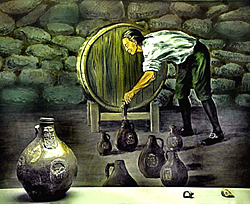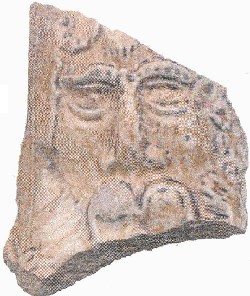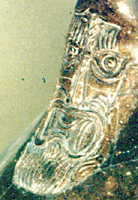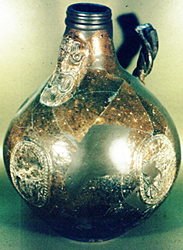DACF Home → Bureaus & Programs → Bureau of Parks and Lands → Discover History & Explore Nature → History & Historic Sites → Colonial Pemaquid → Bellarmine Jugs
Bellarmine Jugs
 Note: The Bellarmine jug discovered at Colonial Pemaquid and usually on display at the museum is on loan to Colonial Williamsburg through January 2011 as part of an exhibit there titled "Pottery With a Past: Stoneware in Early America."
Note: The Bellarmine jug discovered at Colonial Pemaquid and usually on display at the museum is on loan to Colonial Williamsburg through January 2011 as part of an exhibit there titled "Pottery With a Past: Stoneware in Early America."
A round-bellied, narrow-necked vessel with a bearded mask, at first collectively called Bartmanner (bearded men) and made at Frechen, near Cologne, in the 15th century. It was changed in mockery into the likeness of Cardinal Bellarmine, and became popular with Protestants under the name bellarmine or gray-beard as a coarse retort to the cardinal's unanswerable arguments against Protestantism in his Controversies.
From the middle of the fifteenth century until 1700 an important trade developed between the Germans, the English, the French, and the Dutch. These very durable jugs were used for wines, ale, oil, vinegar, or water. A prominent feature of these bottles is a bearded human face which ornaments the neck opposite the handle and below the thickened lip.


The affectionately-known "old Gray-beard", an icon of Bellarmine jugs and their time.
When the site of the 1607 Popham colony on the Maine coast was being excavated in the mid-1990s fragments of Bellarmine stood out among the other pottery, being "stoneware" rather than "earthenware." Nine "sherds" of it were found in 1995 alone. One such fragment, photographed after a later expedition, is shown here.
Bellarmine has a fine texture, and "a uniform light grey" color and, along the outside, a thin glaze with "a brownish tinge." Its surface was treated with salt, rather than lead or tin, meaning that '[t]he vaporizing of the salt during glazing creates a characteristic pitted, or "orange peel" appearance.
Dr. J.P. Brain comments that these "pot-bellied jugs ... were standard for the period ... This type originated in the Rhineland. It was widely used as a reliable nonporous shipping and storage container for a variety of liquids before glass bottles became widely available in the mid-seventeenth century." [emphasis added]
 "Molded medallions and masks were frequently added in the seventeenth century. Two of these sherds [shown above] exhibit floral and other design elements from medallions typical of the early seventeenth century (Ivor No?l Hume, pers. comm. to Alaric Faulkner, 1988) ...
"Molded medallions and masks were frequently added in the seventeenth century. Two of these sherds [shown above] exhibit floral and other design elements from medallions typical of the early seventeenth century (Ivor No?l Hume, pers. comm. to Alaric Faulkner, 1988) ...
To the left, the fragment's "[f]eatured motif is the rampant lion of J?lich whose dukes rules Frenchen where most Bellarmine was made."
This type is also known as "Tigerware," after the distinctive mottled and streaked appearance of the glaze, as "Frechen," after the district in the Rhineland where most of it was made, and as "Bartmann," "d'Alva," or "graybeard" when the stylized face masks are applied to the neck area opposite the handle. Similar ware made in England is called "Fulham," but there is no evidence that it was in production early in the seventeenth century and thus there is no reason to suspect that the Fort St. George stoneware is not the usual Rhenish product.